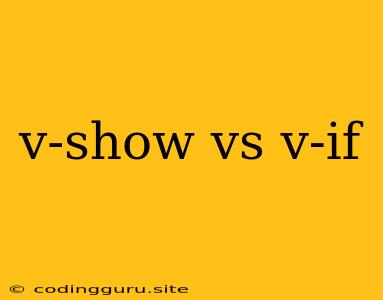v-show vs v-if: A Comprehensive Guide to Conditional Rendering in Vue.js
In the world of Vue.js, conditional rendering is a powerful technique that allows you to dynamically display or hide elements based on certain conditions. Two directives, v-show and v-if, are essential tools for achieving this. While both achieve similar results, they differ in their underlying mechanisms and performance implications. This guide will explore the differences between v-show and v-if, providing insights into when to use each directive effectively.
What is v-show?
The v-show directive controls the display style attribute of an element. When the condition associated with v-show evaluates to true, the element's display style is set to block, making it visible. Conversely, when the condition is false, the display style is set to none, hiding the element.
Example:
Hello, world!
In this example, the <div> element containing "Hello, world!" will be visible initially because showGreeting is set to true. If showGreeting is later changed to false, the element will be hidden.
What is v-if?
The v-if directive, unlike v-show, controls the actual rendering of an element. When the condition associated with v-if is true, the element is created and added to the DOM. If the condition is false, the element is completely removed from the DOM.
Example:
Hello, world!
Similar to the v-show example, the <div> will be rendered and visible when showGreeting is true. However, if showGreeting becomes false, the entire <div> element will be removed from the DOM, completely disappearing from the page.
Key Differences between v-show and v-if:
1. DOM Manipulation:
v-show: Does not manipulate the DOM; simply hides or shows the element usingdisplay: noneordisplay: block.v-if: Removes or adds the element from the DOM based on the condition.
2. Performance:
v-show: Faster for frequent condition changes, as the element remains in the DOM, only changing its visibility.v-if: Can be slower for frequent changes, as the DOM is manipulated for each change.
3. Initial State:
v-show: Element is always present in the DOM, initially hidden or shown based on the condition.v-if: Element is only created and added to the DOM when the condition evaluates totrue.
4. Use Cases:
v-show: Ideal for frequently changing conditions where the element needs to be visually toggled.v-if: Best for situations where the element should be entirely removed from the DOM when not needed.
When to Use v-show:
- Frequently changing conditions: When you expect the visibility of the element to change frequently,
v-showis a good choice due to its better performance. - Fast toggles: If you need to quickly toggle the visibility of an element,
v-showis ideal. - Element remains in the DOM: If the element needs to remain in the DOM even when hidden,
v-showis the right choice.
Example:
Loading...
In this scenario, the "Loading..." message will be displayed when isLoading is true and quickly disappear when isLoading changes to false.
When to Use v-if:
- Infrequent condition changes: When the condition is less likely to change frequently,
v-ifis more performant. - Complete removal: If you need the element to be entirely removed from the DOM when the condition is false,
v-ifis the better option. - Improving SEO: Since
v-ifremoves elements from the DOM, it can potentially improve SEO by ensuring that only relevant content is present in the rendered HTML.
Example:
Here, the "Admin Panel" button will only be rendered if the user is an administrator (isAdmin is true). If the user is not an administrator, the button will be completely removed from the DOM.
v-else and v-if/v-else-if:
You can use v-else with v-if to provide an alternative block of content when the v-if condition is false. Additionally, you can chain multiple conditions using v-if and v-else-if for more complex scenarios.
Example:
In this example, the "Moderator Panel" button will be displayed because isModerator is true, even though isAdmin is false.
Conclusion:
v-show and v-if are crucial directives for conditional rendering in Vue.js. Understanding their differences is essential for making informed decisions about which directive to use. v-show is suitable for frequent condition changes and fast toggles, while v-if is better for infrequent changes and complete element removal. By choosing the appropriate directive, you can ensure optimal performance and maintain a clean and efficient Vue.js application.
